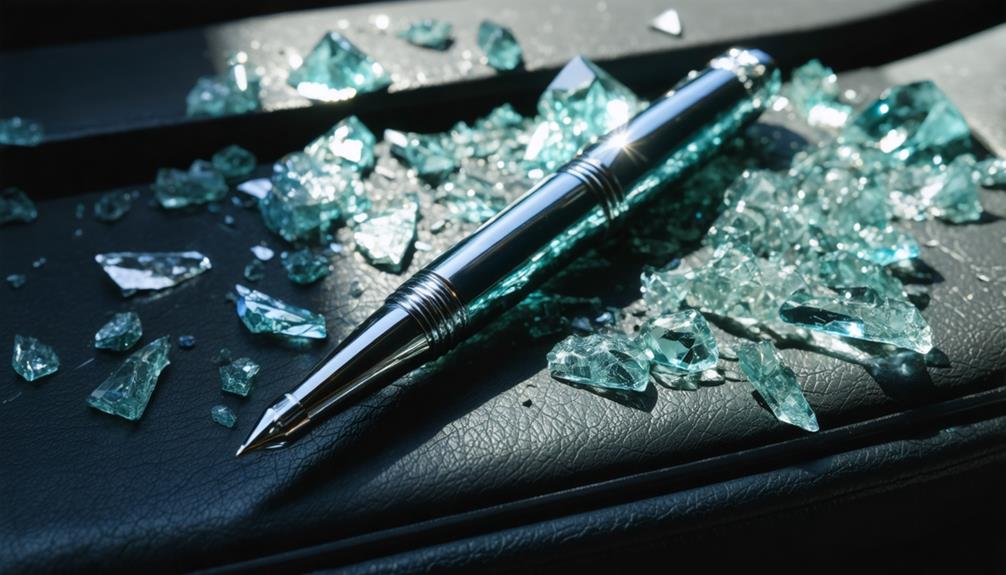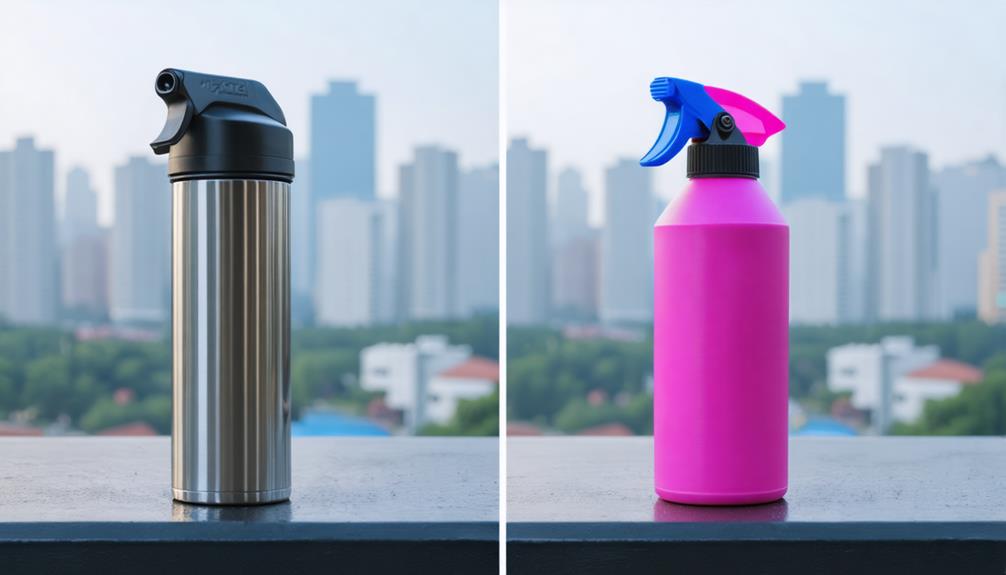
Brainstorm Security Shop

For Orders Over $199

On Any Of Our Products

Details On Refund Page
When you’re considering self-defense options, you might find yourself weighing the benefits of mace vs. pepper spray. Both serve the purpose of incapacitating an attacker, but their key ingredients and effects vary significantly. Mace often uses tear gas for immediate impact, while pepper spray’s potency comes from its natural pepper extracts, leading to intense discomfort. Understanding these differences can help you make an informed choice, but there’s more to consider—like legal restrictions and effectiveness in various situations. What factors should guide your decision on which one to carry?
When it comes to self-defense tools, understanding the difference between mace and pepper spray is crucial. Both products serve as deterrents, but they’ve distinct characteristics that set them apart.
Mace typically contains a combination of tear gas and an irritant, while pepper spray is made from oleoresin capsicum, derived from hot peppers. This fundamental difference affects their effectiveness and usage.
In a strength comparison, pepper spray generally delivers a more intense effect on an attacker, causing immediate pain and temporary blindness. Mace, on the other hand, may not incapacitate as quickly, which could be a concern in high-stress situations.
Safety concerns also arise when choosing between the two. While both can be effective, improper use of mace can lead to unintended harm to bystanders or yourself, particularly if wind direction shifts. Pepper spray tends to be safer in enclosed areas or during windy conditions. By understanding these differences, you can make an informed decision on which tool best fits your self-defense needs while considering both effectiveness and safety in real-world applications.
Understanding the key ingredients and formulations of mace and pepper spray is essential for making an informed choice. Both products contain active ingredients that determine their effectiveness and use cases.
Mace typically includes a chemical compound like CS gas or a tear gas agent, designed to cause temporary blindness and disorientation. Its formulation is often stronger, focusing on creating an immediate incapacitation effect, which can be beneficial in situations requiring high protection levels.
On the other hand, pepper spray primarily contains oleoresin capsicum (OC), derived from hot peppers. This formulation causes intense irritation to the eyes and respiratory system, making it effective for self-defense. The active ingredient in pepper spray is often measured in Scoville Heat Units (SHU), providing a clear indication of its potency.
When considering your options, think about your use cases. If you seek a product for personal safety in various scenarios, pepper spray may be the better choice due to its accessibility and effectiveness. Mace, while powerful, can be more suitable for law enforcement or security professionals needing a stronger deterrent. Understanding these key differences will help you select the right tool for your protection needs.
When it comes to the mechanism of action, understanding the chemical composition differences between mace and pepper spray is crucial.
You’ll notice that their delivery methods also vary, impacting how effectively they reach the target.
Let’s explore how each type affects its intended victim and why that matters in a self-defense situation.
Mace and pepper spray differ significantly in their chemical compositions, which directly affects their mechanisms of action. Mace typically contains a combination of tear gas (CS gas) and other irritants, while pepper spray is primarily made from oleoresin capsicum, derived from hot peppers. This fundamental difference means that their toxicity levels aren’t the same. Mace can pose higher toxicity risks, especially with prolonged exposure, leading to more severe side effects like respiratory distress and skin irritation.
On the other hand, pepper spray is generally considered less toxic, with side effects mainly involving temporary blindness, coughing, and intense burning sensations. While both are designed to incapacitate an attacker, the way they affect the body differs due to their chemical makeup. When you use mace, you might experience more pronounced effects due to the higher toxicity levels, potentially leading to complications if not used properly.
In contrast, pepper spray’s active ingredient causes inflammation and pain but is less likely to result in serious harm. Understanding these chemical composition differences can help you make informed decisions about personal safety tools.
The differences in chemical composition between mace and pepper spray lead to distinct delivery methods and mechanisms of action. Mace typically uses an aerosol delivery system, dispersing its formula in a fine mist. This allows for a wider area coverage, but it can be less effective in windy conditions.
On the other hand, pepper spray often utilizes a stream delivery method, which provides a more targeted approach. This can be advantageous for hitting a specific target with less chance of blowback.
Here’s a quick comparison to consider:
Understanding these delivery methods can help you choose the right option for your needs, ensuring you’re prepared for various scenarios. Ultimately, the choice between mace and pepper spray hinges on how you want to deliver your defense.
Understanding the effects on targets is crucial for choosing between mace and pepper spray. Both have distinct mechanisms that affect individuals differently.
When you use mace, it primarily contains chemicals like CS gas, which cause intense pain and irritation upon contact. You’ll notice a high pain intensity that can last anywhere from 15 to 30 minutes, making it effective for self-defense.
On the other hand, pepper spray contains capsaicin, derived from hot peppers, which creates a burning sensation in the eyes and skin. This intense eye irritation forces the target to close their eyes, temporarily blinding them. The respiratory effects can also be significant; targets may experience coughing, choking, and difficulty breathing, especially if they’ve asthma or other respiratory conditions.
In terms of duration, pepper spray effects can last from 20 minutes to an hour, depending on the concentration and wind conditions. While both mace and pepper spray are designed to incapacitate, you need to consider the specific pain intensity and the duration of effects based on your personal safety needs. Choose wisely to ensure you’re prepared in any situation.
When it comes to self-defense, knowing the effectiveness of your options is crucial. Both mace and pepper spray serve as deterrents, but their effectiveness can vary based on circumstances. Mace typically contains tear gas and can incapacitate an attacker, while pepper spray uses capsaicin, causing intense burning and temporary blindness.
To maximize your self-defense strategy, consider these safety tips:
Both options can provide you with a sense of security, but it’s essential to practice regularly. By incorporating safety tips and training techniques into your routine, you’ll enhance your ability to respond effectively in a self-defense scenario.
Many people overlook the legal considerations surrounding mace and pepper spray, but these factors can significantly impact your ability to carry and use these self-defense tools. Different states and countries have varying laws about the legality of these items, often defining their use, size limits, and even the specific formulations. Ignoring these legal implications can lead to serious consequences, including fines or criminal charges.
Safety concerns also play a crucial role in these regulations. Authorities prioritize public safety, which often results in stricter laws regarding self-defense tools. You need to be aware of your local laws to ensure you’re compliant and can use your chosen defense method without legal repercussions.
Public perception and cultural norms further influence how mace and pepper spray are viewed. In some communities, carrying these tools might be seen as a proactive safety measure, while in others, it could raise eyebrows and spark concern. Understanding the societal attitudes around these tools can help you navigate the complexities of legal considerations and restrictions effectively.
Always stay informed and ensure that your self-defense choices align with both the law and cultural expectations in your area.
In navigating the choice between mace and pepper spray, it’s essential to consider your specific needs and circumstances. Both options serve as personal safety devices, but they differ in composition and effectiveness. You should evaluate your safety concerns, the environment you’ll be in, and any legal restrictions.
Here are a few factors to keep in mind:
Ultimately, understanding these aspects will help you make an informed decision. Whether you lean towards mace or pepper spray, prioritize your safety while being mindful of your surroundings and the potential consequences of your choice.
Yes, both can expire over time. Their shelf life typically ranges from two to four years. Proper storage in a cool, dry place can help maintain effectiveness, but always check expiration dates before use.
Yes, there are different types of pepper spray. You’ll find effectiveness comparisons among various formulations, but remember to check legal restrictions and always follow safety precautions to ensure you’re using it responsibly.
To store your self-defense spray properly, keep it in a cool, dry place away from direct sunlight. Check the shelf life regularly, as expired products may not function effectively when you need them most.
If you accidentally spray yourself, immediately rinse your eyes with water for at least 15 minutes. Use treatment options like milk or saline. For future safety, always follow prevention tips and keep your distance when spraying.
Yes, animals can be affected by mace or pepper spray. During wildlife encounters, it’s crucial to consider pet safety. Always keep your pets away from these substances to ensure their well-being and avoid harmful reactions.
